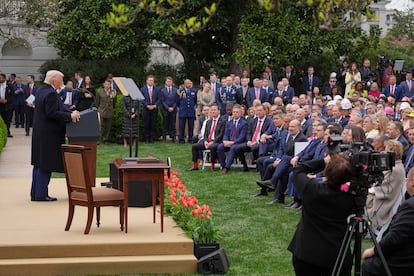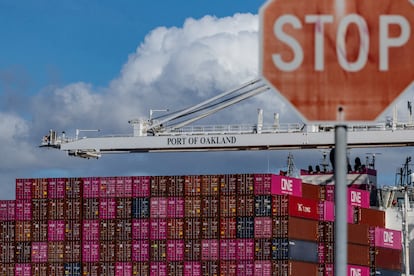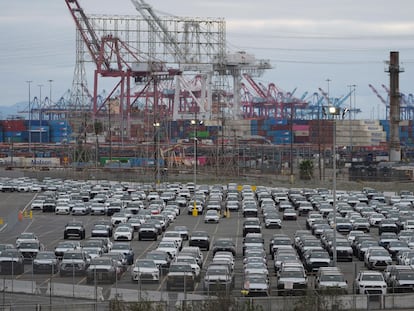Trump declares a trade war on the world with universal tariffs of 10% and higher rates on his main trading partners
The President of the United States announces the highest import taxes in a century, with a 20% surcharge on EU products

The history of the world economy took a turn this Wednesday in the White House Rose Garden, in front of the Oval Office. U.S. President Donald Trump wanted to lend a special solemnity to the announcement of tariffs on the third date he had christened “Liberation Day” in recent months. On a cloudy day, Trump darkened the economic horizon with the highest tariffs in a century. The United States will impose a minimum universal tariff of 10% on all imports and will further punish the countries and blocs with which it has the largest trade deficits, including the European Union, on which it will impose a 20% tariff.
Trump has shown a chart with the tariffs of major trading partners: the European Union (20%); China (34%); Japan (24%); Vietnam (46%); Taiwan (32%); India (26%); South Korea (25%); Thailand (36%); Switzerland (31%); Indonesia (32%); Brazil and the United Kingdom (10%). The president claims without substantiation that this is half of the burdens these countries impose on the United States. For now, Canada and Mexico are still subject to the national emergency declared in relation to fentanyl and migration, so the new regime does not apply to them. The 25% rate is maintained for imports that do not comply with the USMCA trade agreement, and those that do comply are exempt. In the case of China, however, the 34% rate is added on top of the 20% already being applied with the excuse of fighting fentanyl, bringing the total to 54%, to which must be added the tariffs on specific products slapped on by Trump during his first term in office and by his successor Joe Biden.
After delivering a speech full of resentment and thirst for revenge, Trump signed a decree that raises a wall on imports from other countries, a measure that he believes will bring the United States into a golden age. Instead, economists fear he will unleash a trade war that will plunge the United States and some of its trading partners into recession. Trump’s tariffs are an attack even on America’s traditional partners and allies. In that sense, it is also a new swipe at the geopolitical chessboard and a blow to globalization. “April 2 will be remembered as the day U.S. industry was born again. We have been cheated for more than 50 years, but it is not going to happen again,” he emphasized.
The president gave his speech with members of his cabinet, congress members, other authorities and industrial workers as guests. Behind him he had large flags of the United States. Trump proclaimed “America’s economic independence day” while spewing false figures to justify his measures.
Trump decided to put tariffs at the center of his economic policy in a sort of trip back to the 19th century, when they were the main source of revenue for the U.S. Treasury. The president wants import taxes to raise hundreds of billions of dollars annually, which would make it easier for him to finance other tax cuts. At the same time, he wants them to serve to revitalize the country’s industrial production by making imported goods more expensive. The two objectives are in conflict with each other.
The White House propaganda apparatus dubbed Wednesday’s event “Make America Wealthy Again,” one of the variations of the classic Trump slogan. The president took the opportunity to launch his biggest protectionist barrage, with what he improperly calls “reciprocal” tariffs. But the tariffs are not reciprocal, however much Trump insists on it. What the U.S. is seeking is to significantly reduce or eliminate its high trade deficit of $1.2 trillion in 2024.

In his false narrative, all countries have been ripping off the United States for decades and what his government is doing is responding in a benevolent manner. In fact, White House sources claim without substantiation that the tariffs imposed are half of what would be appropriate for reciprocity of treatment. In reality, Trump is blowing up the rules of global trade, unleashing an earthquake of unforeseeable consequences. Governments around the world are preparing their responses in the form of retaliation, aid to affected sectors or concessions to Washington, depending on their negotiating strategy.
Discussions on the scope of the reciprocal tariffs have dragged on until the last minute within the Trump Administration, which has been swinging back and forth with its trade policy. The uncertainty created has weighed down the U.S. economy even before the full extent of its measures have been known.
On Tuesday morning, White House press secretary Karoline Leavitt said the tariffs would take effect immediately, but events have once again left her in a bad light. The tariffs will not be applied immediately, but the general tariff will take effect next Saturday and the so-called reciprocal tariffs will be applied as of April 9.

The new tariffs are in addition to those already in place. In early February, Trump introduced a 10% tariff on all Chinese goods imported into the United States. Smaller shipments were then exempted. A month later, the tax was doubled to 20%. In early March, a 25% general levy on most imports from Canada and Mexico went into effect. Two days later, a large series of exemptions were announced for products covered by the Mexico-U.S.-Canada Agreement (USMCA). On March 12, tariffs of 25% on steel and aluminum imports went into effect. On March 26, a 25% tax on auto imports was announced to tax assembled vehicles from April 3 and major components and parts from May 3.
For the future, moreover, Trump has mentioned semiconductors, pharmaceuticals, food, copper, lumber (and even on one occasion oil) as other goods that could face new import taxes. The president has also authorized Secretary of State Marco Rubio to impose 25% tariffs on countries buying oil from Venezuela.
Sign up for our weekly newsletter to get more English-language news coverage from EL PAÍS USA Edition
Tu suscripción se está usando en otro dispositivo
¿Quieres añadir otro usuario a tu suscripción?
Si continúas leyendo en este dispositivo, no se podrá leer en el otro.
FlechaTu suscripción se está usando en otro dispositivo y solo puedes acceder a EL PAÍS desde un dispositivo a la vez.
Si quieres compartir tu cuenta, cambia tu suscripción a la modalidad Premium, así podrás añadir otro usuario. Cada uno accederá con su propia cuenta de email, lo que os permitirá personalizar vuestra experiencia en EL PAÍS.
¿Tienes una suscripción de empresa? Accede aquí para contratar más cuentas.
En el caso de no saber quién está usando tu cuenta, te recomendamos cambiar tu contraseña aquí.
Si decides continuar compartiendo tu cuenta, este mensaje se mostrará en tu dispositivo y en el de la otra persona que está usando tu cuenta de forma indefinida, afectando a tu experiencia de lectura. Puedes consultar aquí los términos y condiciones de la suscripción digital.
More information
Archived In
Últimas noticias
The metaverse, four years later: Is it finished or just at a standstill?
$3,000 and a plane ticket: The United States increases incentives for migrants to self-deport before the end of the year
Charles Dubouloz, mountaineering star, retires at 36 with a farewell tour inspired by Walter Bonatti
From the White House to diplomatic gifts: Lego wins over adult fans, brick by brick
Most viewed
- The low-cost creative revolution: How technology is making art accessible to everyone
- Families demand repatriation of bodies of Colombians who died in Ukraine: ‘This war is a slaughterhouse for foreigners’
- Christian Louboutin: ‘Young people don’t want to be like their parents. And if their parents wear sneakers, they’re going to look for something else’
- All the effects of gentrification in one corner of Mexico’s Colonia Roma
- Christmas loses its festive spirit: ICE fears cast shadow over religious celebrations










































